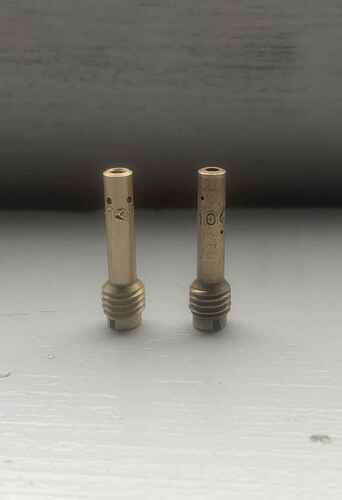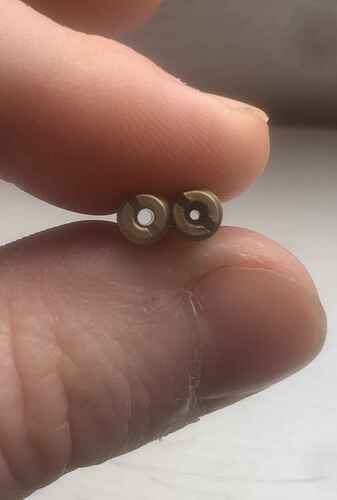I actually checked the app above, for $15 I think is totally worth it. I would use it 99% of the time to compare options and learn how the variables interact vs blindly picking one of the suggested combos (which, btw, seem pretty reasonable). Good value considering the time it takes to model all that…but I think you still need to learn the difference between a K23 and a K98 to then interpret the outputs…It’s quite simple once you get the hang of it, so I think you probably still need the old school tables and the graph Evan put together to then understand what you see in the app and expect from the engine on track
Yeah, it has been invaluable for me this season. I like that you could compare different setups etc and gives you lots of different setups to play with if you want.
The suggested setups has worked flawlessly in terms of performance, and the engine always runs clean and strong. Of course I don’t blindly uses all the suggested setups but it has always give me a direction to go on certain days.
But as you say, knowledge is more valuable than an app. So I certainly have to dig more and learn the differences between needles and all the other variables ![]()
Cross-posting from @Andy_DiGiusto’s thread, since I think it would be good to discuss in more detail here…
Here a couple pics to illustrate the difference between the CD1 (left) and B100 (right) idle emulsion tubes.
Andy- I have yet to test the CD1 on track, but are you able to speak to the difference in how these perform? Also, what is the relationship between the idle jet and idle emulsion tube? Is there a time where we should change one and not the other to create a desired jetting outcome?
Here is a dump of everything I learned.
With the other combinations, the end result is dictated by the combo of emulsion tube and jet on top.
With CD1, what matters is the jet on top, as the CD1 flows an enormous amount of fuel.
There are few schools of thought here, I believe all correct in their own way. One says that in general, you should use CD1 only with big jets (70 or more) on top, otherwise it makes no sense as you can fine tune better with the combo tube/jet.
However many race teams use CD1 with smaller jets on top like 60 62 or 65 that is done probably for two reasons. One is practicality, as you eliminate one variable, much easier to keep the tube constant and max flow, then dial in the top only. The other is velocity, I’m not an expert in fluidodynamics but with the same 60 jet on top, a CD1 will deliver more un-atomized fuel at faster speed, since it offers minimal restriction, which probably helps when you are running a lean max jet
How would this app work with the TM M1 which is a 135cc with a 34mm carb?
Don’t know, there isn’t an option for 34mm carb size or the M1 unfortunately ![]()
Great work and great thread. I found this tidbit from another thread and am using it as a starting point because this seems like the best place:
In general, the needles with smaller tips will allow you to run a leaner main jet vs those with the 1.8mm tip, sometime 6-8 sizes leaner depending on the needle & atomizer.
Relatedly what kind of statement could be made about needle clip positions and the main jet size?? (e.g., ‘each position you go richer on the clip position allows you to run x-number of main jet sizes leaner’)
I wouldn’t necessarily think of clip position from that standpoint. While there is some overlap of what each affects, here’s how I think of clip position when tuning:
-
The most impactful effect from changing clip position will be the timing of coming onto the needle taper, and thus the timing of fuel delivery relative to throttle position.
-
Based on the above, clip position will affect fuel delivery at WOT (where main jet plays biggest role), but that effect will be lesser in proportion to say 20% and 50% throttle.
-
Clip position can be a quick way to richen/lean the curve if main jet is already close. See all of the old Tkart vids where Franco is brapping someone’s kart, makes a quick clip change, then braps again giving them a thumbs up at the end lol.
-
With certain needle combos I’m more inclined to change clip position, others not so much. Depends on the track, conditions, etc. etc…just based on where my tuning experimentation has taken me, there is a correlation between aggressiveness of the needle and how often I change the clip position. More specifically, with aggressive needles (more/faster fuel delivery) I just set it and forget it. With “gentler” needles, e.g. K28/K22, I’m more inclined to play with the clip. In hindsight, I’d think it would be the other way around, but whatever…that’s my data. YMMV as this is just based on my experience.
-
Even when I am making clip changes, I generally find an operating range of about 1 position. For example, I may start at P3 with a K28 and then make half-step changes until I land at P2.
As with any time you’re experimenting with carburetion changes, the following rules ALWAYS apply if you want to tune “safely”. If you have YOLO money going into your engine program then disregard ![]()
- Always start rich
- Always make small changes when working towards “kill”
Lastly, provided you’re tuning on a TM (that’s the engine I’m most familiar with), then I’d advise starting with the carb as it comes out of the box, break-in, swap the tube for DQ268, and just leave the K98 needle. Until you’re familiar (and maybe you already are) with the ins/outs of all aspects of the Dellorto there’s not really much use in overcomplicating the carburetion. This also assumes you’re in the US and running one of the readily available leaded race fuels (fuel is a whole other topic). “Step 2” would be to experiment with K28, K22, K23, as those will give you a wide range of options. Beyond that, buckle up and may god be with you ![]()
Thanks your response was more than I hoped for. I’m actually running a Rok GP with the VHSH 30 and, for now, am planning to run it according to the rules which basically limit me to adjusting the main jet, the needle position only (k33 needle), the air screw, and the option to change from CD1 inner pilot to B45. I notice that the race shop I got a couple engines from seem to be running a considerably leaner main jet size but richer needle position than recommend by a jetting app I’m looking at (“Jetting Rok”). Trying to pick apart the thinking there.
Makes sense. The principals will all apply, but in a way it’s nice to have the rules constraining the range of changes you can make. Sounds like the Rok GP just needs more fuel across the curve, so by doing so they’re also able to lean the main jet. I’m not very familiar with that engine, but it’s very mid-range heavy, and seemingly always geared for that, so on the limiter very early at most tracks with any sort of tight corners.
Hi Everyone,
Circling back to this but bring airboxes into the discussion. Is there a jetting difference or suggested starting point going from the NOX airbox to the Nitro on an R2?
Nothing significant. Atmospheric conditions will be more important, so I would start with what you’d normally consider to be rich jetting and then adjust from there.
I feel like this is the right place to bring this up and get my confusion solved.
Im running a Rok Shifter so my options for jetting are pretty limited. Im currently running a 145-165 main jet configuration, k98 needle, b50 pilot, and have the clip in either p2 or 3.
The problem im experiencing is bucking in corners especially on corner exit. @Muskabeatz thought it could have been something with the bottom end being too rich. I dont exactly know what that means. If someone could go in depth on why this could potentially be happening that would be swell.
As mentioned in the other thread, I would first confirm that you have a beefy enough return spring on the throttle pedal. This is a bigger deal than most people think, and many beginners look over it.
If the above is already addressed, then I would make sure you’re rolling onto the throttle gently, and not stabbing at it when making your initial input.
If the issue still persists then I would raise the clip position, and then open the air screw in 1/4 turn increments. The Rok should run pretty well bas you have it configured, or with some minor adjustments.
I definitely have a big enough return spring. I put a bigger one on there last year when this started happening. The spring improved the bucking but occationally (at bumpy tracks primarily) it stil happens.
The pilot jets will definitely have an effect here, but the main jet will also. My Rok I have to keep around 1300F on the peak egt to not get that partial throttle bucking.
Thats about where im at too with my EGTs. Right around 1300
So what should i do?
You said a b50 inner, what about the outer?
On the stand you can get a pretty good idea of how you’re jetted by how the engine sounds at various points in the throttle throw. Zero to 1/4 opening is going to be mostly your pilot jets doing the work, 1/4 to 1/2 is the needle mostly, and beyond half is main jet. On the stand you can move your pedal approximately 1/4 of the full throw, hows the engine sound? If it’s stuttering than you’re rich on the pilots, a little flutter is okay. Continue to open up to 1/2 and what does it do? Before you do this test do a couple clean outs at full throttle to make sure it isn’t loaded up. In my experience I can have a little flutter at the 1/4 opening and be fine, as long as it cleans up in the 1/2 open area.
Hi guys currently running Modena kk3 with following base setup
Dp 267
60 inner
60 outer
K23 top clip washer underneath
168 main
Would be interested to hear thoughts on other setups and if any current apps are good to use

